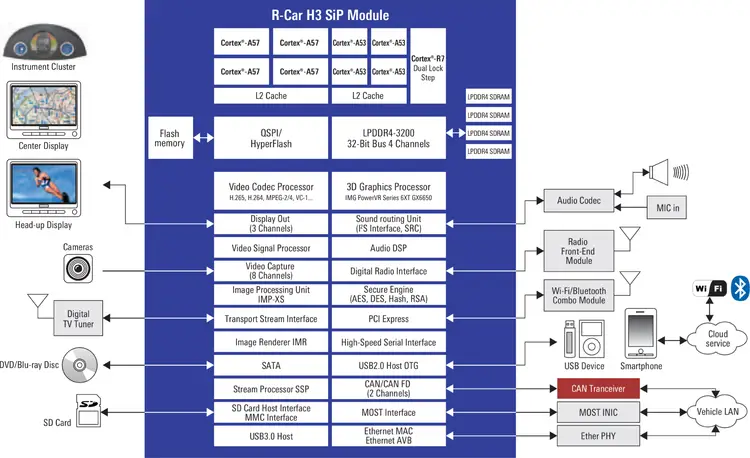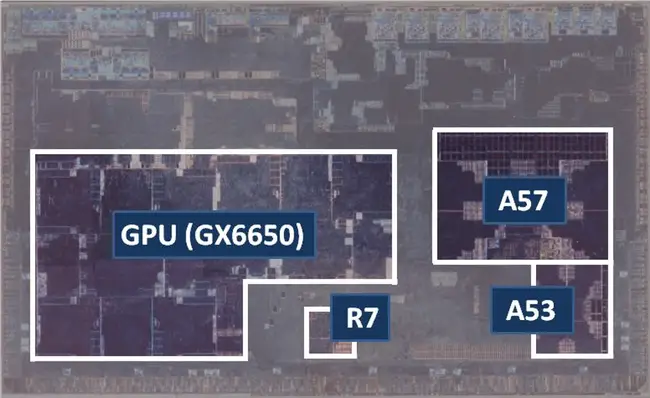From WikiChip
Difference between revisions of "renesas/r-car/h3"
| Line 28: | Line 28: | ||
|die width=8.61 mm | |die width=8.61 mm | ||
|word size=64 bit | |word size=64 bit | ||
| − | |core count= | + | |core count=9 |
| − | |thread count= | + | |thread count=9 |
|max cpus=1 | |max cpus=1 | ||
|v core=0.8 V | |v core=0.8 V | ||
| Line 35: | Line 35: | ||
|package module 1={{packages/renesas/fcbga-1384}} | |package module 1={{packages/renesas/fcbga-1384}} | ||
}} | }} | ||
| − | '''R-Car H3''' is a {{arch|64}} [[ | + | '''R-Car H3''' is a {{arch|64}} [[nona-core]] [[ARM]] SoC designed by [[Renesas]] for the automotive industry and introduced in 2016. The H3 incorporates four {{armh|Cortex-A57}} cores, four {{armh|Cortex-A53}} cores, and a dual-core lock-step {{armh|Cortex-R7}} for real-time processing. This chip supports up to quad-channel LPDDR4-3200 memory. This chip incorporates the [[imagination technologies|Imagination]]'s {{imgtec|PowerVR GX6650}} [[GPU]]. |
Samples for the H3 were available starting December 2015 with Renesas expecting mass production to begin in March 2018 and reach a volume of 100,000 units per month in March 2019. | Samples for the H3 were available starting December 2015 with Renesas expecting mass production to begin in March 2018 and reach a volume of 100,000 units per month in March 2019. | ||
| Line 42: | Line 42: | ||
{{main|arm holdings/microarchitectures/cortex-a53#Memory_Hierarchy|arm holdings/microarchitectures/cortex-a57#Memory_Hierarchy|l1=Cortex-A53 § Cache|l2=Cortex-A57 § Cache}} | {{main|arm holdings/microarchitectures/cortex-a53#Memory_Hierarchy|arm holdings/microarchitectures/cortex-a57#Memory_Hierarchy|l1=Cortex-A53 § Cache|l2=Cortex-A57 § Cache}} | ||
{{cache size | {{cache size | ||
| − | |l1 cache= | + | |l1 cache=640 KiB |
| − | |l1i cache= | + | |l1i cache=352 KiB |
| − | |l1i break=4x48+ | + | |l1i break=4x48+5x32 KiB |
| − | |l1d cache= | + | |l1d cache=288 KiB |
| − | |l1d break= | + | |l1d break=9x32 KiB |
|l2 cache=2.5 MiB | |l2 cache=2.5 MiB | ||
}} | }} | ||
| Line 112: | Line 112: | ||
== Block Diagram == | == Block Diagram == | ||
:: [[File:r-car h3 block.png|750px]] | :: [[File:r-car h3 block.png|750px]] | ||
| + | |||
| + | == Die Shot == | ||
| + | * [[16 nm process]], CMOS FinFET | ||
| + | * 12.94 mm × 8.61 mm | ||
| + | * 111.36 mm² die size | ||
| + | |||
| + | |||
| + | :: [[File:r-car h3 die shot.png|650px]] | ||
| + | |||
| + | == References == | ||
| + | * Takahashi, Chikafumi, et al. "4.5 A 16nm FinFET heterogeneous nona-core SoC complying with ISO26262 ASIL-B: Achieving 10− 7 random hardware failures per hour reliability." Solid-State Circuits Conference (ISSCC), 2016 IEEE International. IEEE, 2016. | ||
Revision as of 06:09, 23 July 2017
Template:mpu R-Car H3 is a 64-bit nona-core ARM SoC designed by Renesas for the automotive industry and introduced in 2016. The H3 incorporates four Cortex-A57 cores, four Cortex-A53 cores, and a dual-core lock-step Cortex-R7 for real-time processing. This chip supports up to quad-channel LPDDR4-3200 memory. This chip incorporates the Imagination's PowerVR GX6650 GPU.
Samples for the H3 were available starting December 2015 with Renesas expecting mass production to begin in March 2018 and reach a volume of 100,000 units per month in March 2019.
Contents
Cache
- Main articles: Cortex-A53 § Cache and Cortex-A57 § Cache
|
Cache Organization
Cache is a hardware component containing a relatively small and extremely fast memory designed to speed up the performance of a CPU by preparing ahead of time the data it needs to read from a relatively slower medium such as main memory. The organization and amount of cache can have a large impact on the performance, power consumption, die size, and consequently cost of the IC. Cache is specified by its size, number of sets, associativity, block size, sub-block size, and fetch and write-back policies. Note: All units are in kibibytes and mebibytes. |
|||||||||||||||||||||||||
|
|||||||||||||||||||||||||
Memory controller
|
Integrated Memory Controller
|
||||||||||||||
|
||||||||||||||
Expansions
- PCI Express2.0 (1 lane) x 2 ch
- USB 3.0 Host interface (DRD) × 1 ports (wPHY)
- USB 2.0 Host/Function/OTG interface × 2 ports (wPHY)
- SD Host interface × 4 ch (SDR104)
- Multimedia card interface × 2 ch
- Serial ATA interface × 1 ch
- Media local bus (MLB) Interface × 1 ch (3 pin interface)
- Controller Area Network (CAN-FD support) Interface × 2ch
- Ethernet AVB 1.0-compatible MAC built in Interface: RGMII / Ethernet AVB (802.1BA)
- SYS-DMAC x 48 ch, Realtime-DMAC x 16 ch,
- Audio-DMAC x 32 ch, Audio(peripheral)-DMAC x 29 ch
- 32bit timer x 26 ch
- PWM timer × 7 ch
- I2C bus interface × 7 ch
- Serial communication interface (SCIF) × 11 ch
- Quad serial peripheral interface (QSPI) x 2 ch (for boot, HyperFlash support)
- Clock-synchronized serial interface (MSIOF) × 4 ch (SPI/IIS)
- Ethernet controller (IEEE802.3u, RMII, without PHY)
- Digital radio interface (DRIF) × 4 ch
Graphics
|
Integrated Graphics Information
|
||||||
|
||||||
Features
[Edit/Modify Supported Features]
|
Supported ARM Extensions & Processor Features
|
||||||
|
||||||
Block Diagram
Die Shot
- 16 nm process, CMOS FinFET
- 12.94 mm × 8.61 mm
- 111.36 mm² die size
References
- Takahashi, Chikafumi, et al. "4.5 A 16nm FinFET heterogeneous nona-core SoC complying with ISO26262 ASIL-B: Achieving 10− 7 random hardware failures per hour reliability." Solid-State Circuits Conference (ISSCC), 2016 IEEE International. IEEE, 2016.
Facts about "R-Car H3 - Renesas"
| has ecc memory support | false + |
| integrated gpu | PowerVR GX6650 + |
| integrated gpu designer | Imagination Technologies + |
| l1$ size | 640 KiB (655,360 B, 0.625 MiB) + |
| l1d$ size | 288 KiB (294,912 B, 0.281 MiB) + |
| l1i$ size | 352 KiB (360,448 B, 0.344 MiB) + |
| l2$ size | 2.5 MiB (2,560 KiB, 2,621,440 B, 0.00244 GiB) + |
| max memory bandwidth | 47.68 GiB/s (48,824.32 MiB/s, 51.196 GB/s, 51,196.01 MB/s, 0.0466 TiB/s, 0.0512 TB/s) + |
| max memory channels | 4 + |
| supported memory type | LPDDR4-3200 + |

